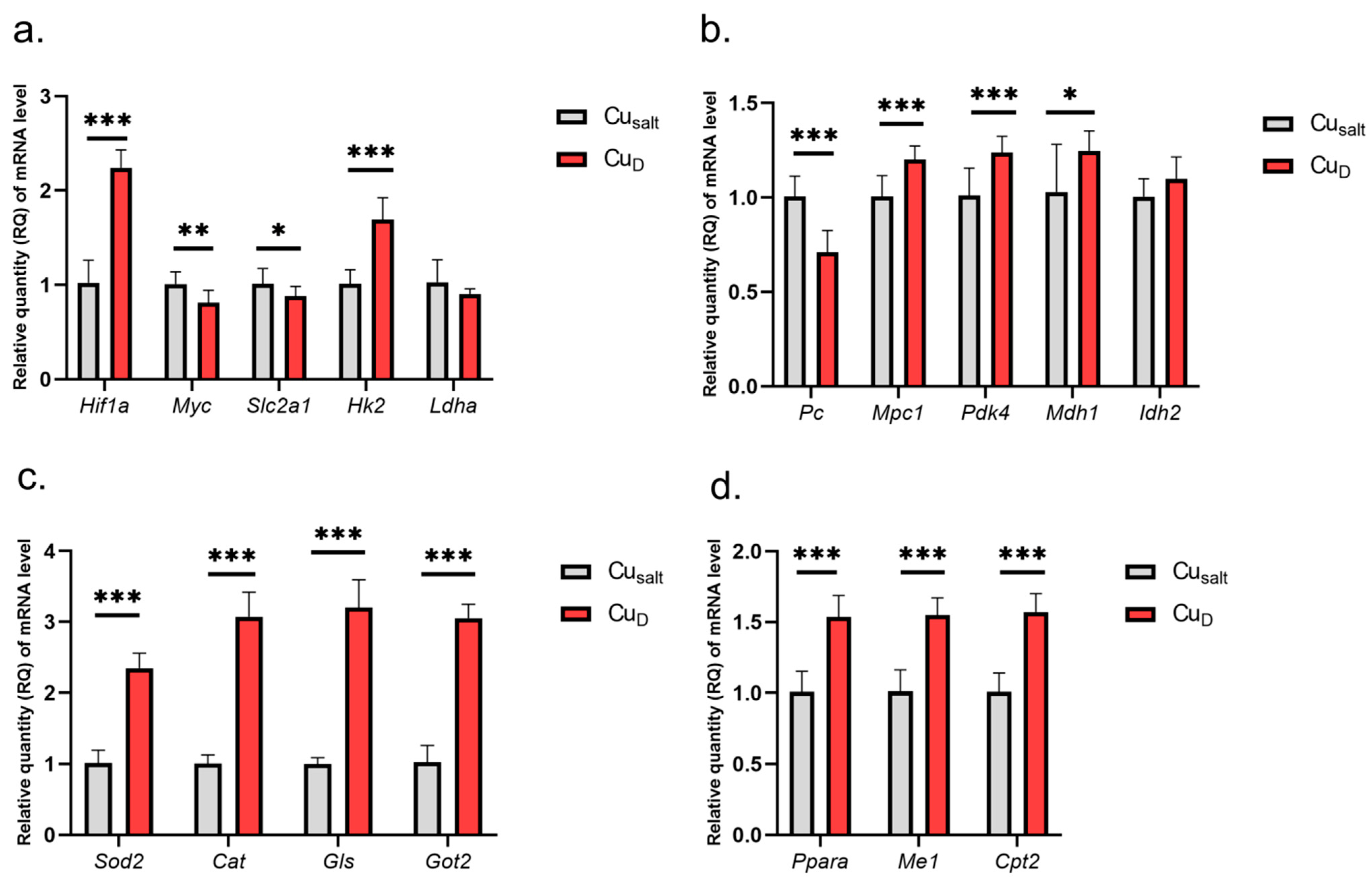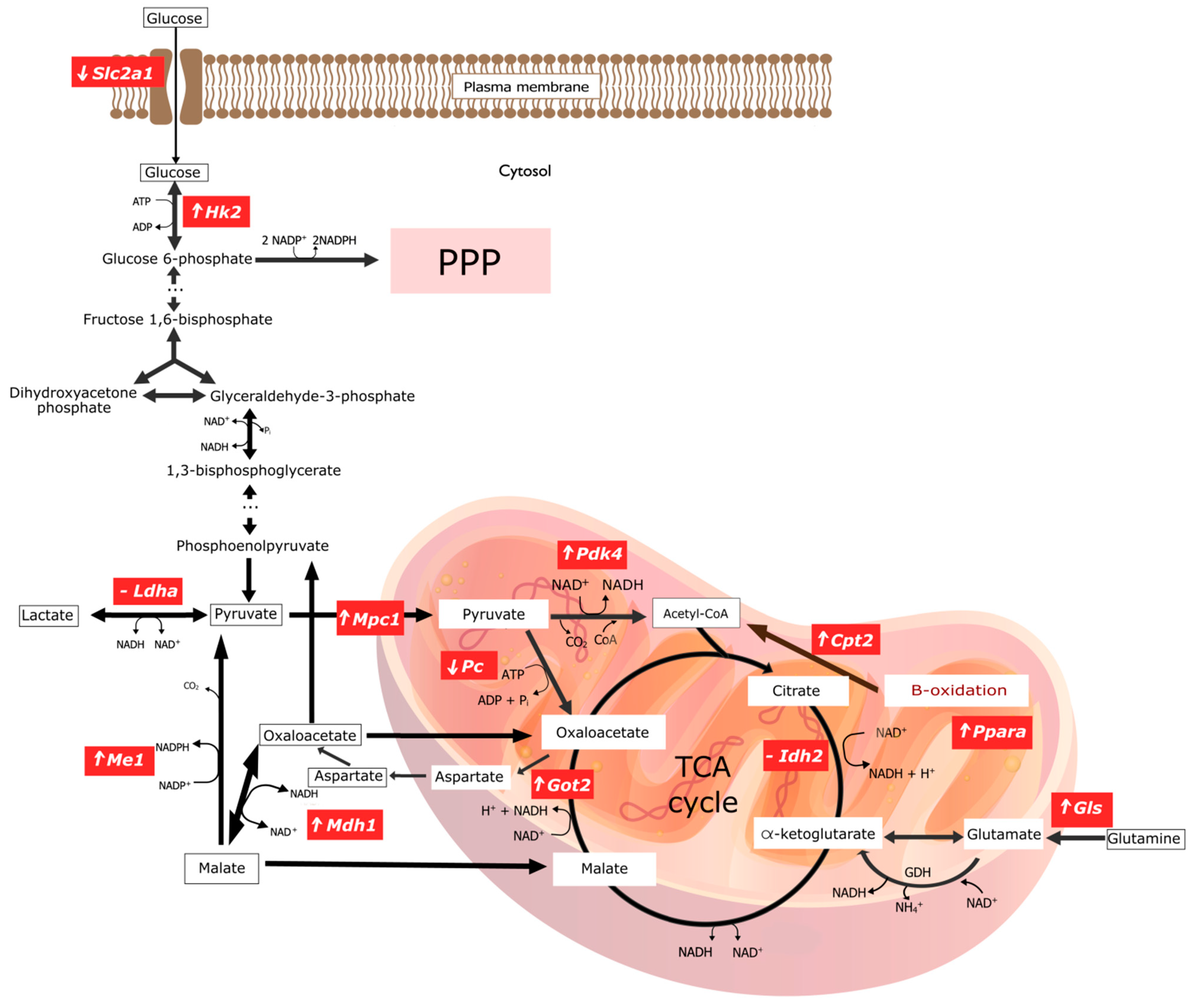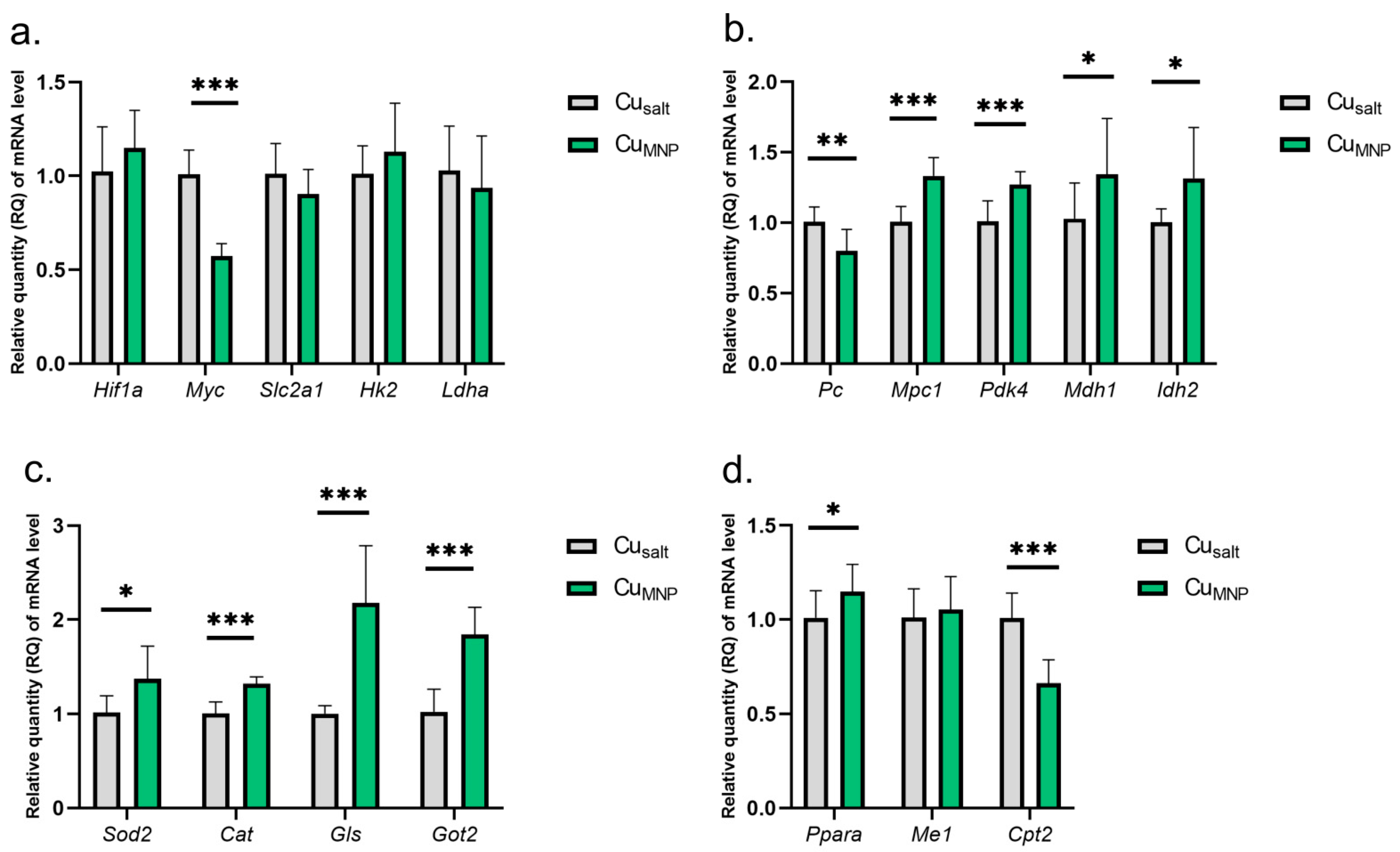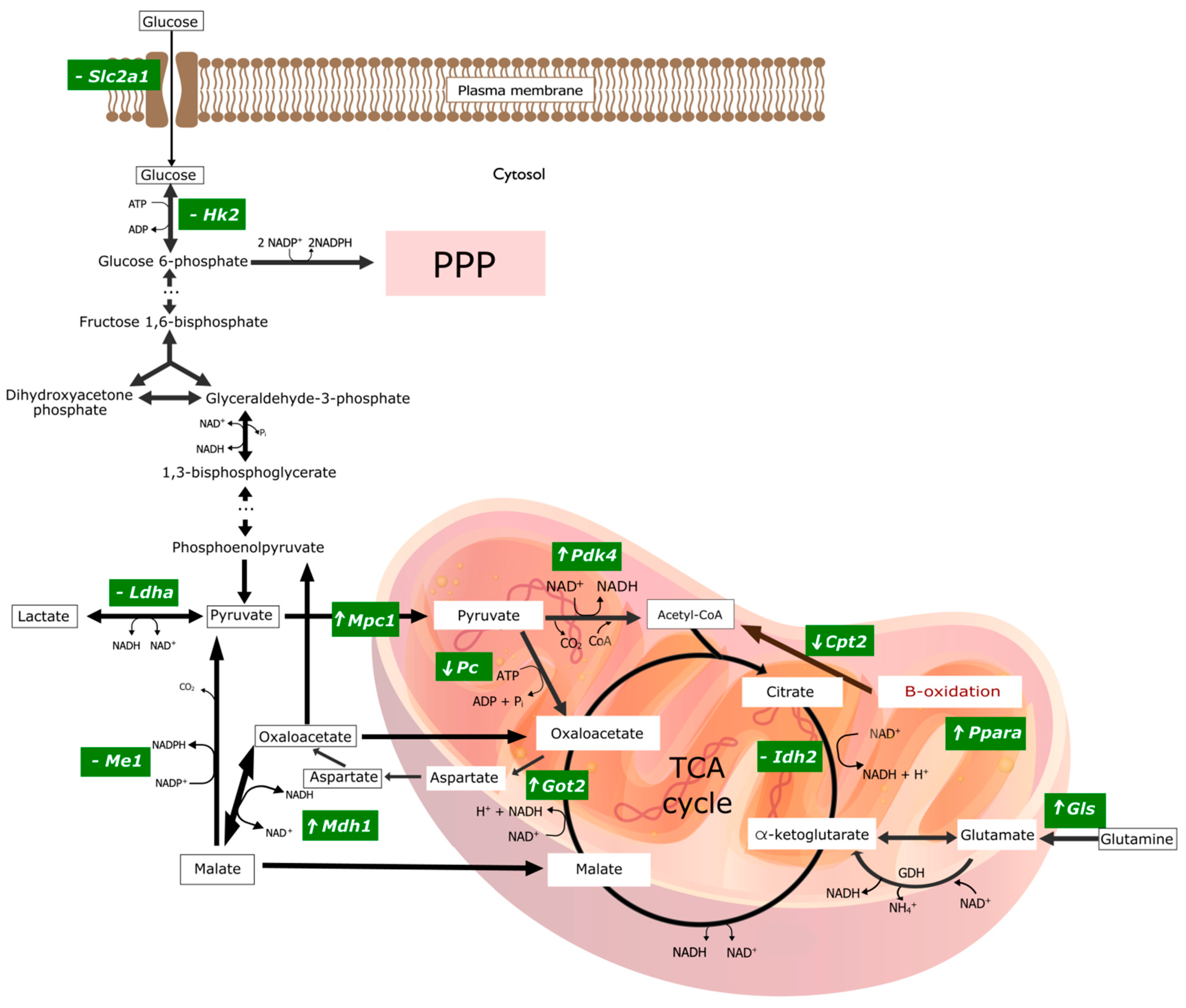Dietary Copper Deficiency Leads to Changes in Gene Expression Indicating an Increased Demand for NADH in the Prefrontal Cortex of the Rat’s Brain
Abstract
1. Introduction
2. Results
3. Discussion
3.1. Changes Caused by the Copper Deprivation from the Diet
3.2. Changes Caused by Replacing the Mineral Copper with a Metallic Form in the Diet
3.3. Limitations of the Study
4. Materials and Methods
4.1. Nanoparticles Characterization
4.2. Animal Breeding
4.3. Dietary Treatment
4.4. Experimental Design
4.5. Material Collection
4.6. The Quantitative Real-Time PCR Analysis (qPCR)
4.6.1. RNA Isolation
4.6.2. cDNA Synthesis
4.6.3. Real-Time PCR
4.7. Statistical Analysis
5. Conclusions
Supplementary Materials
Author Contributions
Funding
Institutional Review Board Statement
Informed Consent Statement
Data Availability Statement
Conflicts of Interest
References
- Royer, A.; Sharman, T. Copper Toxicity; StatPearls Publishing: Treasure Island, FL, USA, 2021. [Google Scholar]
- Kumar, V.; Kalita, J.; Misra, U.K.; Bora, H.K. A Study of Dose Response and Organ Susceptibility of Copper Toxicity in a Rat Model. J. Trace Elem. Med. Biol. 2015, 29, 269–274. [Google Scholar] [CrossRef]
- Kumar, V.; Kalita, J.; Bora, H.K.; Misra, U.K. Temporal Kinetics of Organ Damage in Copper Toxicity: A Histopathological Correlation in Rat Model. Regul. Toxicol. Pharmacol. 2016, 81, 372–380. [Google Scholar] [CrossRef] [PubMed]
- Ognik, K.; Sembratowicz, I.; Cholewińska, E.; Jankowski, J.; Kozłowski, K.; Juśkiewicz, J.; Zduńczyk, Z. The Effect of Administration of Copper Nanoparticles to Chickens in Their Drinking Water on the Immune and Antioxidant Status of the Blood. Anim. Sci. J. 2018, 89, 579–588. [Google Scholar] [CrossRef]
- Ognik, K.; Cholewińska, E.; Juśkiewicz, J.; Zduńczyk, Z.; Tutaj, K.; Szlązak, R. The Effect of Copper Nanoparticles and Copper (II) Salt on Redox Reactions and Epigenetic Changes in a Rat Model. J. Anim. Physiol. Anim. Nutr. 2019, 103, 675–686. [Google Scholar] [CrossRef] [PubMed]
- Cholewińska, E.; Fotschki, B.; Juśkiewicz, J.; Rusinek-Prystupa, E.; Ognik, K. The Effect of Copper Level in the Diet on the Distribution, and Biological and Immunological Responses in a Rat Model. J. Anim. Feed Sci. 2018, 27, 349–360. [Google Scholar] [CrossRef]
- Cholewińska, E.; Juśkiewicz, J.; Ognik, K. Comparison of the Effect of Dietary Copper Nanoparticles and One Copper (II) Salt on the Metabolic and Immune Status in a Rat Model. J. Trace Elem. Med. Biol. 2018, 48, 111–117. [Google Scholar] [CrossRef] [PubMed]
- DiNicolantonio, J.J.; Mangan, D.; O’Keefe, J.H. Copper Deficiency May Be a Leading Cause of Ischaemic Heart Disease. Open Heart 2018, 5, e000784. [Google Scholar] [CrossRef] [PubMed]
- Ruiz, L.M.; Libedinsky, A.; Elorza, A.A. Role of Copper on Mitochondrial Function and Metabolism. Front. Mol. Biosci. 2021, 8, 711227. [Google Scholar] [CrossRef] [PubMed]
- Ferguson-Miller, S.; Babcock, G.T. Heme/Copper Terminal Oxidases. Chem. Rev. 1996, 96, 2889–2908. [Google Scholar] [CrossRef] [PubMed]
- Tapiero, H.; Townsend, D.M.; Tew, K.D. Trace Elements in Human Physiology and Pathology. Copper. Biomed. Pharmacother. 2003, 57, 386–398. [Google Scholar] [CrossRef]
- Angelova, M.; Asenova, S.; Nedkova, V.; Koleva-Kolarova, R. Copper in the Human Organism. Trakia J. Sci. 2011, 9, 11. [Google Scholar]
- Blomberg, M.R.A. The Redox-Active Tyrosine Is Essential for Proton Pumping in Cytochrome c Oxidase. Front. Chem. 2021, 9, 100. [Google Scholar] [CrossRef] [PubMed]
- Gromadzka, G.; Tarnacka, B.; Flaga, A.; Adamczyk, A. Copper Dyshomeostasis in Neurodegenerative Diseases—Therapeutic Implications. Int. J. Mol. Sci. 2020, 21, 9259. [Google Scholar] [CrossRef]
- Maung, M.T.; Carlson, A.; Olea-Flores, M.; Elkhadragy, L.; Schachtschneider, K.M.; Navarro-Tito, N.; Padilla-Benavides, T. The Molecular and Cellular Basis of Copper Dysregulation and Its Relationship with Human Pathologies. FASEB J. 2021, 35, e21810. [Google Scholar] [CrossRef] [PubMed]
- Prohaska, J.R. Impact of Copper Deficiency in Humans. Ann. N. Y. Acad. Sci. 2014, 1314, 1–5. [Google Scholar] [CrossRef]
- Behl, S.; Mehta, S.; Pandey, M.K. Abnormal Levels of Metal Micronutrients and Autism Spectrum Disorder: A Perspective Review. Front. Mol. Neurosci. 2020, 13, 586209. [Google Scholar] [CrossRef] [PubMed]
- Ejaz, H.W.; Wang, W.; Lang, M. Copper Toxicity Links to Pathogenesis of Alzheimer’s Disease and Therapeutics Approaches. Int. J. Mol. Sci. 2020, 21, 7660. [Google Scholar] [CrossRef] [PubMed]
- Mathys, Z.K.; White, A.R. Copper and Alzheimer’s Disease. Adv. Neurobiol. 2017, 18, 199–216. [Google Scholar] [CrossRef] [PubMed]
- Liu, X.; Zhong, S.; Li, Z.; Chen, J.; Wang, Y.; Lai, S.; Miao, H.; Jia, Y. Serum Copper and Zinc Levels Correlate with Biochemical Metabolite Ratios in the Prefrontal Cortex and Lentiform Nucleus of Patients with Major Depressive Disorder. Prog. Neuro-Psychopharmacol. Biol. Psychiatry 2020, 99, 109828. [Google Scholar] [CrossRef] [PubMed]
- Awais, M.H.; Aamir, M.; Bibi, A.; Ali, S.; Ahmed, W.; Safdar, S.A. Association of Trace Metals in Patients with Schizophrenia. J. Coll. Physicians Surg. Pak. 2022, 32, 193–196. [Google Scholar] [CrossRef] [PubMed]
- Johnson, W.T.; Newman, S.M. Copper Deficiency: A Potential Model for Determining the Role of Mitochondria in Cardiac Aging. J. Am. Aging Assoc. 2003, 26, 19–28. [Google Scholar] [CrossRef] [PubMed]
- Chen, X.; Jennings, D.B.; Medeiros, D.M. Impaired Cardiac Mitochondrial Membrane Potential and Respiration in Copper-Deficient Rats. J. Bioenerg. Biomembr. 2002, 34, 397–406. [Google Scholar] [CrossRef] [PubMed]
- Famitafreshi, H.; Karimian, M. Modulation of Catalase, Copper and Zinc in the Hippocampus and the Prefrontal Cortex in Social Isolation-Induced Depression in Male Rats. Acta Neurobiol. Exp. 2019, 79, 184–192. [Google Scholar] [CrossRef]
- Carroll, W.M. The Global Burden of Neurological Disorders. Lancet Neurol. 2019, 18, 418–419. [Google Scholar] [CrossRef]
- Singh, A.; Kukreti, R.; Saso, L.; Kukreti, S. Oxidative Stress: A Key Modulator in Neurodegenerative Diseases. Molecules 2019, 24, 1583. [Google Scholar] [CrossRef] [PubMed]
- Misrani, A.; Tabassum, S.; Yang, L. Mitochondrial Dysfunction and Oxidative Stress in Alzheimer’s Disease. Front. Aging Neurosci. 2021, 13, 617588. [Google Scholar] [CrossRef]
- Aronson, J.K. Defining ‘Nutraceuticals’: Neither Nutritious nor Pharmaceutical. Br. J. Clin. Pharmacol. 2017, 83, 8–19. [Google Scholar] [CrossRef]
- Makkar, R.; Behl, T.; Bungau, S.; Zengin, G.; Mehta, V.; Kumar, A.; Uddin, M.S.; Ashraf, G.M.; Abdel-Daim, M.M.; Arora, S.; et al. Nutraceuticals in Neurological Disorders. Int. J. Mol. Sci. 2020, 21, 4424. [Google Scholar] [CrossRef]
- Tirpe, A.A.; Gulei, D.; Ciortea, S.M.; Crivii, C.; Berindan-Neagoe, I. Hypoxia: Overview on Hypoxia-Mediated Mechanisms with a Focus on the Role of HIF Genes. Int. J. Mol. Sci. 2019, 20, 6140. [Google Scholar] [CrossRef]
- Koepsell, H. Glucose Transporters in Brain in Health and Disease. Pflügers Arch.-Eur. J. Physiol. 2020, 472, 1299–1343. [Google Scholar] [CrossRef]
- Liu, B.; Bai, W.; Ou, G.; Zhang, J. Cdh1-Mediated Metabolic Switch from Pentose Phosphate Pathway to Glycolysis Contributes to Sevoflurane-Induced Neuronal Apoptosis in Developing Brain. ACS Chem. Neurosci. 2019, 10, 2332–2344. [Google Scholar] [CrossRef] [PubMed]
- Li, X.; Li, Y.; Han, G.; Li, X.; Ji, Y.; Fan, Z.; Zhong, Y.; Cao, J.; Zhao, J.; Mariusz, G.; et al. Establishment of Mitochondrial Pyruvate Carrier 1 (MPC1) Gene Knockout Mice with Preliminary Gene Function Analyses. Oncotarget 2016, 7, 79981–79994. [Google Scholar] [CrossRef] [PubMed][Green Version]
- Zangari, J.; Petrelli, F.; Maillot, B.; Martinou, J.-C. The Multifaceted Pyruvate Metabolism: Role of the Mitochondrial Pyruvate Carrier. Biomolecules 2020, 10, 1068. [Google Scholar] [CrossRef] [PubMed]
- Melkonian, E.A.; Asuka, E.; Schury, M.P. Physiology, Gluconeogenesis; StatPearls Publishing: Treasure Island, FL, USA, 2021. [Google Scholar]
- Yip, J.; Geng, X.; Shen, J.; Ding, Y. Cerebral Gluconeogenesis and Diseases. Front. Pharmacol. 2017, 7, 521. [Google Scholar] [CrossRef]
- Reshef, L.; Olswang, Y.; Cassuto, H.; Blum, B.; Croniger, C.M.; Kalhan, S.C.; Tilghman, S.M.; Hanson, R.W. Glyceroneogenesis and the Triglyceride/Fatty Acid Cycle. J. Biol. Chem. 2003, 278, 30413–30416. [Google Scholar] [CrossRef]
- Borst, P. The Malate-Aspartate Shuttle (Borst Cycle): How It Started and Developed into a Major Metabolic Pathway. IUBMB Life 2020, 72, 2241–2259. [Google Scholar] [CrossRef]
- Otto-Ślusarczyk, D.; Graboń, W.; Mielczarek-Puta, M. Aminotransferaza asparaginianowa—Kluczowy enzym w metabolizmie ogólnoustrojowym człowieka. Postepy Hig. i Med. Dosw. 2016, 70, 219–230. [Google Scholar] [CrossRef]
- Lamichane, S.; Dahal Lamichane, B.; Kwon, S.-M. Pivotal Roles of Peroxisome Proliferator-Activated Receptors (PPARs) and Their Signal Cascade for Cellular and Whole-Body Energy Homeostasis. Int. J. Mol. Sci. 2018, 19, 949. [Google Scholar] [CrossRef]
- Mirza, A.Z.; Althagafi, I.I.; Shamshad, H. Role of PPAR Receptor in Different Diseases and Their Ligands: Physiological Importance and Clinical Implications. Eur. J. Med. Chem. 2019, 166, 502–513. [Google Scholar] [CrossRef]
- Grabacka, M.; Pierzchalska, M.; Dean, M.; Reiss, K. Regulation of Ketone Body Metabolism and the Role of PPARα. Int. J. Mol. Sci. 2016, 17, E2093. [Google Scholar] [CrossRef]
- Wójtowicz, S.; Strosznajder, A.K.; Jeżyna, M.; Strosznajder, J.B. The Novel Role of PPAR Alpha in the Brain: Promising Target in Therapy of Alzheimer’s Disease and Other Neurodegenerative Disorders. Neurochem. Res. 2020, 45, 972–988. [Google Scholar] [CrossRef] [PubMed]
- D’Orio, B.; Fracassi, A.; Ceru, M.P.; Moreno, S. Targeting PPARalpha in Alzheimer’s Disease. Curr. Alzheimer Res. 2018, 15, 345–354. [Google Scholar] [CrossRef] [PubMed]
- Simmen, F.A.; Alhallak, I.; Simmen, R.C.M. Malic Enzyme 1 (ME1) in the Biology of Cancer: It Is Not Just Intermediary Metabolism. J. Mol. Endocrinol. 2020, 65, R77–R90. [Google Scholar] [CrossRef] [PubMed]
- Joshi, P.R.; Zierz, S. Muscle Carnitine Palmitoyltransferase II (CPT II) Deficiency: A Conceptual Approach. Molecules 2020, 25, 1784. [Google Scholar] [CrossRef]
- Yoo, H.C.; Yu, Y.C.; Sung, Y.; Han, J.M. Glutamine Reliance in Cell Metabolism. Exp. Mol. Med. 2020, 52, 1496–1516. [Google Scholar] [CrossRef]
- Xiao, W.; Wang, R.-S.; Handy, D.E.; Loscalzo, J. NAD(H) and NADP(H) Redox Couples and Cellular Energy Metabolism. Antioxid. Redox Signal. 2018, 28, 251–272. [Google Scholar] [CrossRef]
- Feng, Y.; Xiong, Y.; Qiao, T.; Li, X.; Jia, L.; Han, Y. Lactate Dehydrogenase A: A Key Player in Carcinogenesis and Potential Target in Cancer Therapy. Cancer Med. 2018, 7, 6124–6136. [Google Scholar] [CrossRef]
- Zhao, R.-Z.; Jiang, S.; Zhang, L.; Yu, Z.-B. Mitochondrial Electron Transport Chain, ROS Generation and Uncoupling (Review). Int. J. Mol. Med. 2019, 44, 3–15. [Google Scholar] [CrossRef]
- Pant, K.; Richard, S.; Peixoto, E.; Gradilone, S.A. Role of Glucose Metabolism Reprogramming in the Pathogenesis of Cholangiocarcinoma. Front. Med. 2020, 7, 113. [Google Scholar] [CrossRef]
- Ognik, K.; Tutaj, K.; Cholewińska, E.; Cendrowska-Pinkosz, M.; Dworzański, W.; Dworzańska, A.; Juśkiewicz, J. The Effect of a Rat Diet Without Added Cu on Redox Status in Tissues and Epigenetic Changes in the Brain. Ann. Anim. Sci. 2020, 20, 503–520. [Google Scholar] [CrossRef]
- OJEU Directive 2010/63/EU of the European Parliament and of the Council of 22 September 2010 on the Protection of Animals Used for Scientific Purposes Text with EEA Relevance. Available online: https://eur-lex.europa.eu/LexUriServ/LexUriServ.do?uri=OJ:L:2010:276:0033:0079:en:PDF (accessed on 20 October 2010).
- Chomczynski, P.; Sacchi, N. Single-Step Method of RNA Isolation by Acid Guanidinium Thiocyanate-Phenol-Chloroform Extraction. Anal. Biochem. 1987, 162, 156–159. [Google Scholar] [CrossRef]




| Ingredient | Content |
|---|---|
| Unchangeable ingredients | |
| Casein a | 14.8 |
| DL-methionine | 0.2 |
| Cellulose b | 8.0 |
| Choline chloride | 0.2 |
| Rapeseed oil | 8.0 |
| Cholesterol | 0.3 |
| Vitamin mix c | 1.0 |
| Maize starch d | 64.0 |
| Changeable ingredient | |
| Mineral mix e | 3.5 |
| Calculated content | |
| Crude protein | 13.5 |
| Ingredient | MX with Standard Cu Dosage a | MX Deprived of Cu b |
|---|---|---|
| Calcium carbonate anhydrous CaCO3 | 357.00 | 357.00 |
| Potassium phosphate monobasic K2HPO4 | 196.00 | 196.00 |
| Potassium citrate C6H5K3O7 | 70.78 | 70.78 |
| Sodium chloride NaCl | 74.00 | 74.00 |
| Potassium sulphate K2SO4 | 46.60 | 46.60 |
| Magnesium oxide MgO | 24.00 | 24.00 |
| Microelements mixture | 18.00 | 18.00 |
| Starch | 213.62 | 213.62 |
| Microelements mixture, g/100 g | ||
| Ferric citrate (16.7% Fe) | 31.00 | 31.00 |
| Zinc carbonate ZnCO3 (56%Zn) | 4.50 | 4.50 |
| Manganous carbonate MnCO3 (44.4% Mn) | 23.40 | 23.40 |
| Copper carbonate CuCO3 (55.5% Cu) | 1.85 | 0.00 |
| Potassium iodate KJ | 0.04 | 0.04 |
| Citric acid C6H8O7 | 39.21 | 40.70 |
| Symbol of Group | Type of Group | Administered Diet |
|---|---|---|
| Cusalt | Control (n = 10) | Four-week-diet with mineral mix, containing 6.5 mg Cu/kg; Cu from CuCO3 |
| CuD | Experimental (n = 10) | Four-week-diet with mineral mix, deprived Cu |
| CuMNP | Experimental (n = 10) | Four-week-diet with mineral mix, 6.5 mg Cu/kg; Cu from nanoparticles preparation |
Publisher’s Note: MDPI stays neutral with regard to jurisdictional claims in published maps and institutional affiliations. |
© 2022 by the authors. Licensee MDPI, Basel, Switzerland. This article is an open access article distributed under the terms and conditions of the Creative Commons Attribution (CC BY) license (https://creativecommons.org/licenses/by/4.0/).
Share and Cite
Cendrowska-Pinkosz, M.; Ostrowska-Lesko, M.; Ognik, K.; Krauze, M.; Juskiewicz, J.; Dabrowska, A.; Szponar, J.; Mandziuk, S. Dietary Copper Deficiency Leads to Changes in Gene Expression Indicating an Increased Demand for NADH in the Prefrontal Cortex of the Rat’s Brain. Int. J. Mol. Sci. 2022, 23, 6706. https://doi.org/10.3390/ijms23126706
Cendrowska-Pinkosz M, Ostrowska-Lesko M, Ognik K, Krauze M, Juskiewicz J, Dabrowska A, Szponar J, Mandziuk S. Dietary Copper Deficiency Leads to Changes in Gene Expression Indicating an Increased Demand for NADH in the Prefrontal Cortex of the Rat’s Brain. International Journal of Molecular Sciences. 2022; 23(12):6706. https://doi.org/10.3390/ijms23126706
Chicago/Turabian StyleCendrowska-Pinkosz, Monika, Marta Ostrowska-Lesko, Katarzyna Ognik, Magdalena Krauze, Jerzy Juskiewicz, Anna Dabrowska, Jaroslaw Szponar, and Slawomir Mandziuk. 2022. "Dietary Copper Deficiency Leads to Changes in Gene Expression Indicating an Increased Demand for NADH in the Prefrontal Cortex of the Rat’s Brain" International Journal of Molecular Sciences 23, no. 12: 6706. https://doi.org/10.3390/ijms23126706
APA StyleCendrowska-Pinkosz, M., Ostrowska-Lesko, M., Ognik, K., Krauze, M., Juskiewicz, J., Dabrowska, A., Szponar, J., & Mandziuk, S. (2022). Dietary Copper Deficiency Leads to Changes in Gene Expression Indicating an Increased Demand for NADH in the Prefrontal Cortex of the Rat’s Brain. International Journal of Molecular Sciences, 23(12), 6706. https://doi.org/10.3390/ijms23126706






